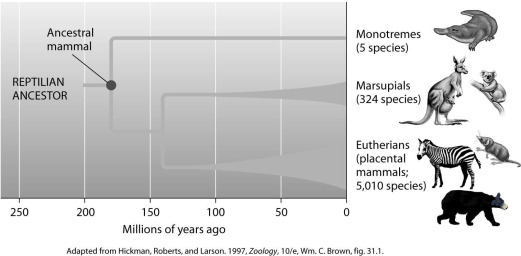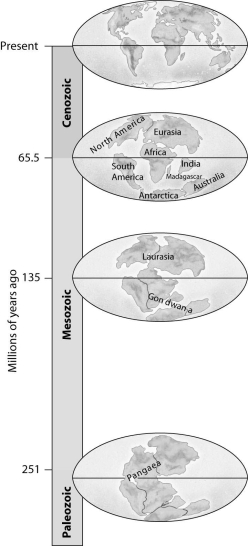A) carbon- containing materials ...up to 75,000 years
B) potassium- rich fossils ...millions of years
C) volcanic rocks and associated fossils ...hundreds of millions of years
D) fossils ...thousands of years
Correct Answer

verified
Correct Answer
verified
Multiple Choice
The earliest known land plants date to the
A) Jurassic (Mesozoic era) .
B) Precambrian.
C) Carboniferous (late Paleozoic era) .
D) Ordovician (early Paleozoic era) .
Correct Answer

verified
Correct Answer
verified
Multiple Choice
If all of Earth's history were compressed into an hour,humans would first appear less than
A) 1 minute ago.
B) 10 minutes ago.
C) 10 seconds ago.
D) 1 second ago.
Correct Answer

verified
Correct Answer
verified
Multiple Choice
A(n) has been used to estimate that HIV- 1 M first spread to humans in the 1930s.
A) epidemiological study
B) parsimony analysis
C) outgroup comparison
D) molecular clock
Correct Answer

verified
Correct Answer
verified
Multiple Choice
Geological evidence indicates that two land masses became separated by a deep ocean channel 45 million years ago and have been moving apart ever since.You are studying a group of organisms that is widespread as a native part of the biota on both of the land masses.What can you conclude about the group's evolutionary history?
A) The group's ancestors cannot have been present on the original land mass before it broke up.
B) The group's ancestors must have independently colonized each of the land masses from a third location within the past 45 million years.
C) The group's ancestors were definitely present on the original land mass before it broke up.
D) It depends on the dispersal abilities of the organism.If the organism cannot move across the open ocean,it is very likely that the group's ancestors were present on the original land mass before it broke up.
Correct Answer

verified
Correct Answer
verified
Multiple Choice
The earliest discovered fossils are of dating back to years ago.
A) algae ...1 billion
B) single- celled eukaryotes 4.5 billion
C) prokaryotes ...3.5 billion
D) fish 600 million
Correct Answer

verified
Correct Answer
verified
Multiple Choice
How can a phylogenetic tree be used to make predictions?
A) Features found in one clade are likely to be found in other clades inhabiting different environments.
B) Features shared between two groups are likely to have been present in their common ancestor.
C) Current trends of evolution will continue into the future.Complex models can be used to accurately predict future branching patterns and the nature of future adaptations.
D) An existing organism's characteristics can be confidently assumed to fit the patterns in the tree.This procedure eliminates the need to collect data about organisms through direct observation or sampling.
Correct Answer

verified
Correct Answer
verified
Multiple Choice
If an isotope has a half- life of 4 million years,and a fossil is 16 million years old,how much of the original isotope will be found in the fossil?
A) one- eighth of the original amount
B) one- quarter of the original amount
C) one- sixteenth of the original amount
D) half the original amount
Correct Answer

verified
Correct Answer
verified
Multiple Choice
Which of the following statements regarding genetics is false?
A) The more recently two species have branched from a common ancestor,the more similar we expect their DNA sequences to be.
B) Gene duplication helps to explain how mammals can detect and discriminate among such a wide range of odors.
C) In keeping with our greater complexity,the human genome has about 100 times more genes than that of yeast.
D) About 99% of the genes of humans and mice are related by descent from a common ancestor.
Correct Answer

verified
Correct Answer
verified
Multiple Choice
The existence of nest- building in crocodiles and birds led to a prediction that this behavior was also present in .
A) fossil dinosaurs
B) invertebrates
C) fossil lizards
D) Komodo dragons
Correct Answer

verified
Correct Answer
verified
Multiple Choice
A spot where two continental plates are sliding past one another may be prone to
A) earthquakes.
B) volcanoes.
C) tsunamis.
D) wildfires.
Correct Answer

verified
Correct Answer
verified
Multiple Choice
Molecular data can be used to assess relationships among the major groups of living organisms whose common ancestors lived millions or billions of years ago.Similar techniques can be used to assess relationships among populations within a species.How can molecular techniques be useful for such varied comparisons?
A) The same data can be used for any comparison with equal efficiency.
B) Faster- evolving gene sequences provide better data for comparisons among close relatives,whereas very slowly evolving sequences work best for distantly related taxa.
C) The relationships between very different groups such as bacteria and whales are assessed using mtDNA sequences,whereas rRNA sequences are used for very closely related groups.
D) Studying the relationships among different populations of a single species can be just as effective as studying the relationships of major biological groups if you look at a lot more genes.
Correct Answer

verified
Correct Answer
verified
Multiple Choice
Which of the following lines of evidence suggests that lungfishes evolved while Pangaea was intact?
A) Lungfishes are restricted to Australia and neighboring islands.
B) Fossil lungfishes have been found on every continent except Antarctica.
C) Modern lungfishes on different continents show similar patterns of behavior.
D) Lungfishes are found today in Africa,Australia,and South America.
Correct Answer

verified
Correct Answer
verified
Multiple Choice
Which highly reactive gas was probably absent from the Earth's primitive atmosphere?
A) O2 (oxygen gas)
B) methane
C) water vapor
D) carbon dioxide
Correct Answer

verified
Correct Answer
verified
Multiple Choice
Which of the following options lists taxonomic categories in the correct order from most specific to most general?
A) family,genus,class,order,phylum
B) family,genus,order,phylum,class
C) genus,family,class,order,phylum
D) genus,family,order,class,phylum
Correct Answer

verified
Correct Answer
verified
Multiple Choice
Anti- evolutionary thinkers sometimes argue that natural selection could not produce a complex structure like the vertebrate eye.They claim that all of the parts of the eye must have arisen at once,asking why natural selection would favor the development of part of an eye that is not yet capable of forming a focused image.Which of the following statements is consistent with a survey of eye structure in the molluscs?
A) The vertebrate eye works in a way that is completely different from the eyes found in molluscs and other invertebrates.
B) There are many intermediate stages of eye complexity that fulfill different adaptive functions.
C) The vertebrate eye is the ancestral form,and other types of organisms have degenerate eyes that have lost most of their original structure and function.
D) The argument has a great deal of merit.Only full- blown image- forming eyes are present in modern organisms.
Correct Answer

verified
Correct Answer
verified
Multiple Choice
You find the frozen remains of a woolly mammoth in an Alaskan glacier.You analyze a bit of the tusk and find that its 14C:12C ratio is about one- fourth (25%) of the baseline level typically found in living organisms.Given that the half- life of 14C is 5,730 years,when did the mammoth die?
A) at least 25,000 years ago
B) almost 12,000 years ago
C) approximately 75,000 years ago
D) 5,730 years ago
Correct Answer

verified
Correct Answer
verified
Multiple Choice
The Himalayas are an example of a mountain range formed as a result of
A) the separation of two continental plates.
B) volcanic eruptions.
C) the buildup of sediments and conversion to rock.
D) the collision of two continental plates.
Correct Answer

verified
Correct Answer
verified
Multiple Choice
According to this figure,during what time frame was there an adaptive radiation of eutherians? 
A) from 100 million years ago to the present
B) about 170 million years ago
C) about 200 million years ago
D) from 140 to 100 million years ago
Correct Answer

verified
Correct Answer
verified
Multiple Choice
According to this figure,if a species were found only in Laurasia 135 million years ago,on which modern continents would its descendants most likely be found today? 
A) North America,Europe,and Asia
B) Africa and South America
C) Europe and Asia only
D) North America only
Correct Answer

verified
Correct Answer
verified
Showing 21 - 40 of 69
Related Exams